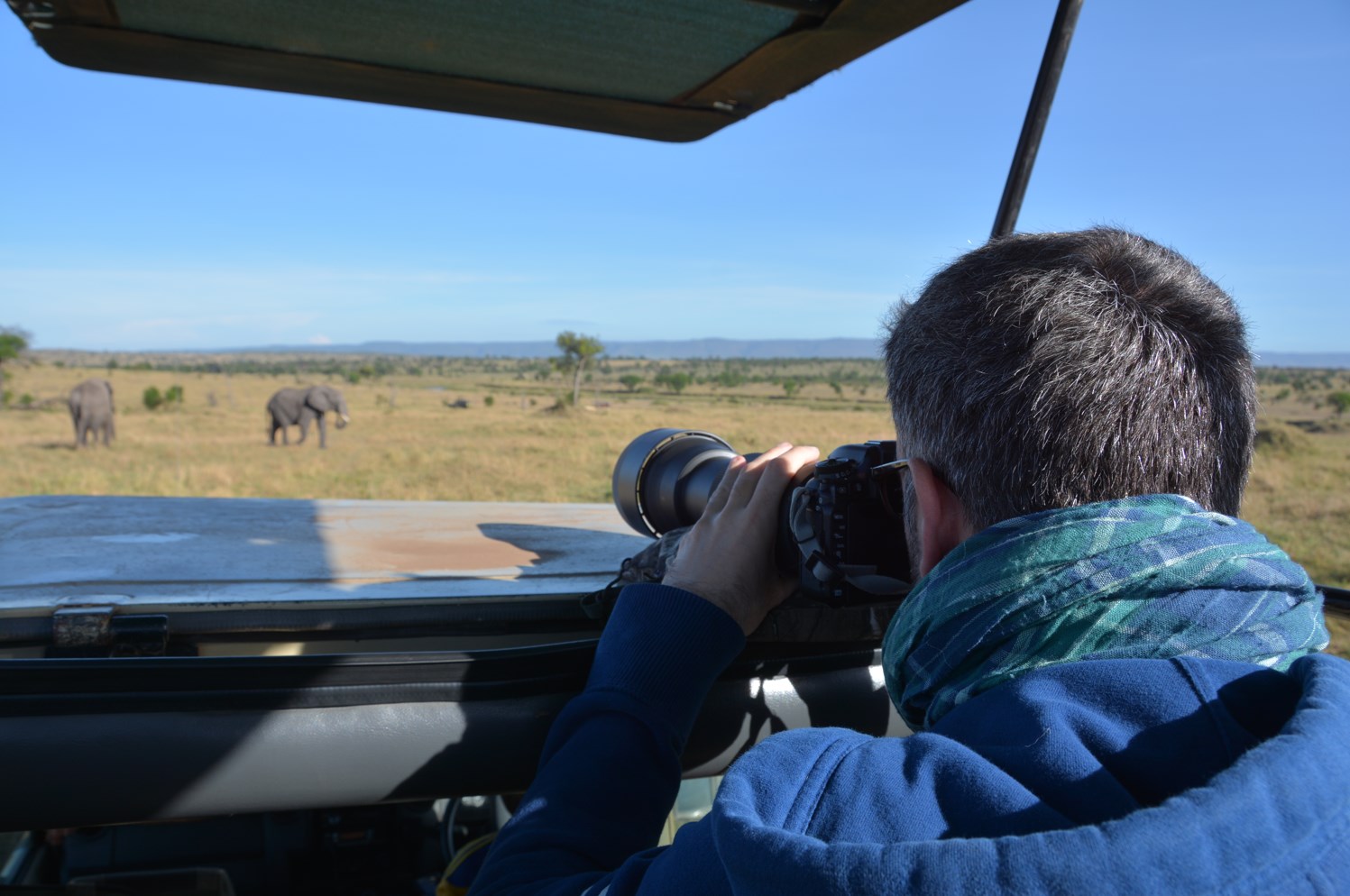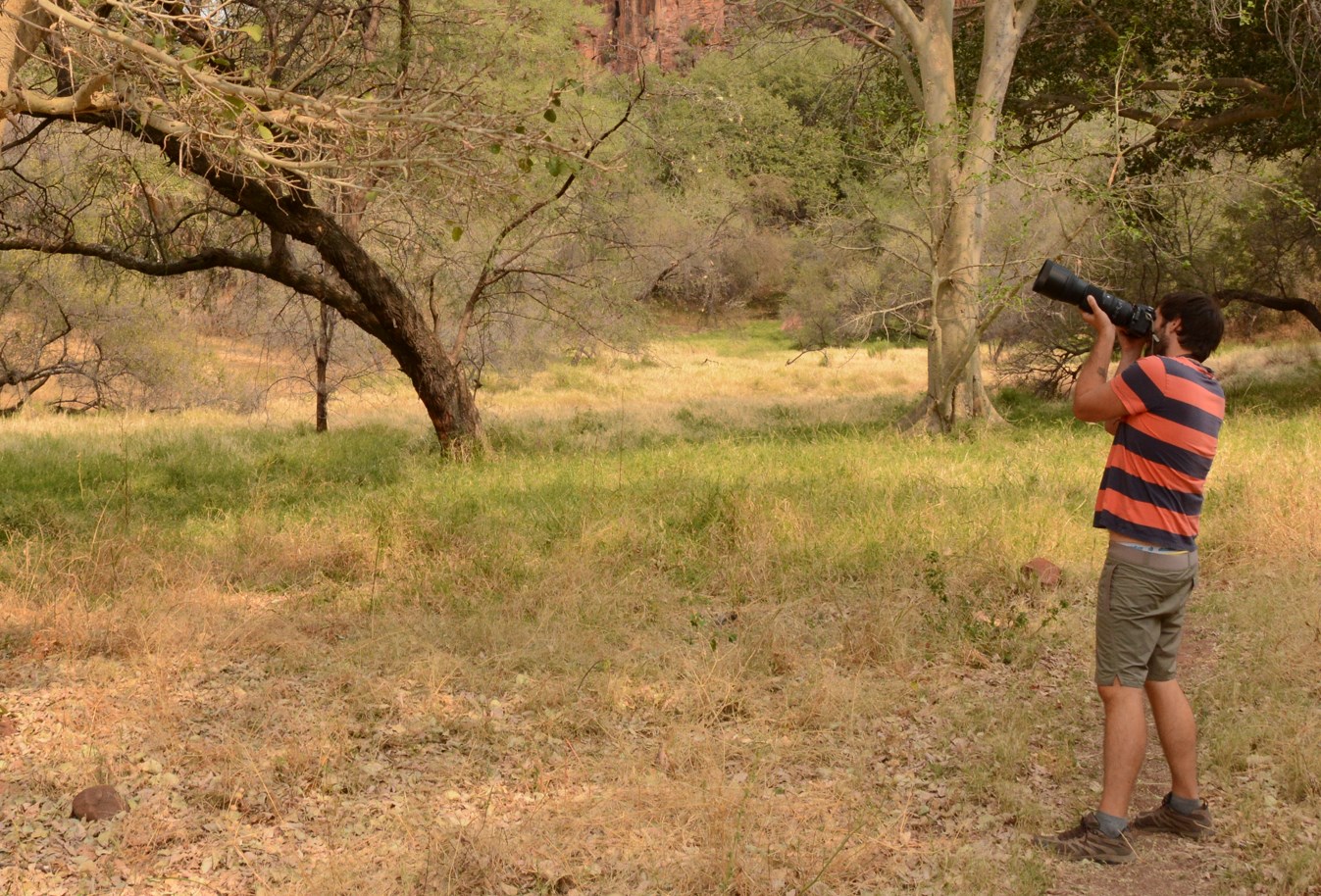GIRAFFE’S TIPS
A safari offers unique opportunities to capture wildlife and the beauty of nature. If you dream of immortalizing an incredible moment of tenderness between a lioness and her cub, the beauty of a herd of elephants walking along a river, or, of course, the elegance and fragility of giraffes, it’s best to prepare a bit.
Going on a safari without knowing how to maximize your chances of successful photos risks disappointment when facing images that don’t reflect what you witnessed.
So, here are all our tips for successful safari photography. Camera gear, settings, and tricks – we’ll cover everything!
 We are François and Benjamin, Canadian and French giraffe hairstylists and travel enthusiasts. On this blog, discover our travels, tips, moods, and everything you need to become a giraffe hairstylist and embark on travelling the world. An honest blog with photos guaranteed 100% unfiltered and untouched. |
What Photo Equipment for Successful Safari Photography?
To capture beautiful photos, having the right gear is crucial. First and foremost, opt for a camera with interchangeable lenses, like a DSLR or mirrorless camera. These types of cameras offer versatility and image quality. Smartphones, even high-quality ones, generally won’t deliver very sharp photos, especially when animals are not very close.
For photographing distant animals, a telephoto lens is essential. A 70-200mm, 100-400mm, or 150-600mm lens is ideal for wildlife photography as they allow you to bring distant subjects closer. It’s worth noting that our eyes tend to zoom, meaning the animal will appear much farther in a non-zoomed photo than what we actually saw.
Conversely, a wide-angle lens (like a 16-50mm) can be useful for capturing broader landscapes and environments. Everyone wants close-up shots of a lion, but it’s important not to forget to take wider shots too. A lion’s habitat varies depending on whether it’s in Botswana, Kenya, or South Africa.

And sometimes, animals get dangerously close to you! A lion might decide to rest in the shade of your car, right under your lens. An elephant might cross the road in front of you. A monkey might leap onto the car hood. In such cases, a telephoto lens might prevent you from taking any photos at all: you’re simply too close!
Ideally, if you already have some gear, consider taking two cameras: one equipped with a telephoto lens and the other with a wide-angle lens. That way, you’ll be ready for any situation! But of course, all this can be quite expensive… Renting equipment is an option to consider: many shops, both in town and online, offer lens and camera rentals by the week. A great way to avoid investing in gear that will only be used once.
To help you, here’s the difference between five photos of the same scene captured at five different focal lengths (levels of zoom). It was our last day in Tanzania, at Tarangire. We were about to leave the park when suddenly we came across this magnificent cheetah. No other cars around. The cheetah was there just for us. We stayed for a very long time enjoying this scene. These five photos were taken with cameras of equivalent quality but at very different focal lengths.
To better understand the impact of focal length, it’s important to delve into the difference between full-frame and APS-C cameras.
| Full-frame and APS-C |
| The difference between a full-frame and an APS-C camera lies in the size of the image sensor inside the camera. A full-frame camera has a larger image sensor, usually the same size as a 35mm film, hence the term “full-frame”. This sensor size offers several advantages, including better image quality in low light, improved depth of field (for more pronounced background blur), and greater ability to capture fine details. An APS-C camera has a smaller image sensor compared to a full-frame. This generally means photos have a less pronounced depth of field. APS-C cameras are typically cheaper than full-frame cameras. Understanding this distinction is crucial for choosing lenses. The focal lengths of lenses vary based on the type of camera (full-frame or APS-C) they are used on. Lenses on a full-frame camera maintain their stated focal length. For instance, a 50mm lens on a full-frame camera actually has a focal length of 50mm. Therefore, if you select a lens for a full-frame camera, the focal length stated on the lens is the actual focal length. However, lenses on an APS-C camera undergo a conversion factor. This conversion factor is generally around 1.5x to 1.6x, although it can vary depending on the camera brand. For instance, a 50mm lens on an APS-C camera would have an equivalent focal length of around 75mm (50mm x 1.5). In simple terms, the same lens will provide greater zoom when used on an APS-C than on a full-frame, which is quite useful for a safari! |
Our five photos were taken with an APS-C camera.





In addition to your camera, don’t forget to bring your lens hood. There can be a lot of sunlight in the parks, and it will help avoid unwanted reflections in your photos.
Stabilizing your camera as much as possible is crucial. It’s impossible to use a tripod because you’ll be in a vehicle. However, a bean bag can be very practical, especially when using a telephoto lens. With an increased focal length comes the risk of blurry images due to movement. The longer the zoom, the more likely tremors will affect the photo. Also, a telephoto lens can weigh several kilos, and spending long periods in front of animals without moving can be challenging.
A bean bag allows you to place the camera on the car’s roof or window. It might get dirty due to the dust accumulated on the vehicle, but it’s still better than soiling your camera! Plus, it offers a lot of flexibility; you can easily switch positions by moving the bean bag from one side of the vehicle to the other. It’s more practical than using a tripod in this situation.

However, remember to buy a bean bag with a rope. It’s essential to attach the bean bag to the car to prevent it from falling (trust us, it can happen quickly!). Because once the bean bag falls, you won’t be able to step out of the car to retrieve it amidst the lions or hyenas…
For the bean bag to be as stable as possible, it would be best to fill it with rice or sand. But due to weight restrictions on airplanes, we fill ours with polystyrene beads, much lighter! And we’ve had no stability issues. One last accessory we recommend: a cloth or a small towel. Place it over your lens and camera when taking photos from the same position for an extended period. Sometimes, you might spend several tens of minutes in front of lion cubs having their meal or elephants bathing. It’s better to reduce the risk of dust getting into your camera…
What Settings to Use for Successful Safari Photography?
During a safari, while many animals relax calmly in the sun, some will move much more swiftly. A cheetah running, a bird taking off, lions mating (yes, that can be very quick): nature can sometimes be very fast-paced.
Here are some basic settings to consider for capturing these fleeting moments.
Shooting Mode: Use Shutter Priority mode (often indicated by an ‘S’ or ‘Tv’ on the mode dial) or switch to Manual mode. This allows you to control the shutter speed, necessary to freeze the movement of animals.
High Shutter Speed: Increase the shutter speed (expressed in seconds or fractions of a second) to avoid motion blur. Since safaris often happen in sunlight, you can use a high shutter speed like 1/1000th of a second or faster to capture the fast movements of animals.


Aperture: Use a small aperture (a high f-number) to limit the amount of light entering the lens. This helps maintain proper exposure in high ambient brightness. An aperture of f/8 or higher is often suitable to achieve extended depth of field and optimal sharpness. The wider the aperture (lower f-number), the more your subject stands out (the background will be blurred), ideal for animal portraits but riskier if the animal is in motion.
Low ISO: In bright conditions, keep the ISO sensitivity as low as possible (ISO 100 or 200) to reduce noise in your photos.
Fast autofocus: Select a fast and responsive autofocus mode, such as continuous autofocus (AF-C for Nikon, AI Servo for Canon), to track the swift movements of animals.
Burst mode: It’s highly recommended to activate burst or continuous shooting mode to capture multiple images in rapid succession when you press the shutter button. This increases your chances of capturing the perfect moment. In wildlife scenes, two photos taken seconds apart can be dramatically different.
Stabilization: If you’re using a telephoto lens, make sure to activate image stabilization (VR for Nikon, IS for Canon) if your lens is equipped. This can help avoid blurring caused by vibrations.
Our Tips to Maximize Your Chances of Capturing Beautiful Safari Photos
Prepare your camera in advance and keep it close at hand to not miss any opportunity. Generally, a lot of time on safari is spent waiting, but action can happen at any moment, and it doesn’t always last long. Therefore, it’s important not to keep your camera in your bag. Instead, always be ready to shoot quickly to capture fleeting moments.
To capture the most beautiful photos, it’s crucial to be as discreet as possible. An animal that feels threatened or disturbed by noise or commotion around it may move away to find a quieter place. In general, on safari, the animals are in their domain, and it’s our duty to respect their tranquility.

Acquiring a basic understanding of animal behavior can help anticipate their movements and get better shots.
Final advice: as always, even though we love photography, the main thing is to appreciate the present moment. There are incredible animals, and sometimes equally impressive flora, right in front of us. So, let’s not keep our eyes glued to the camera and let’s enjoy it to the fullest!
Are you traveling in the northern part of the planet? Find all our tips to succeed in capturing photos of the Northern Lights:
Discover our tips for selecting your photography gear for your next trip:




